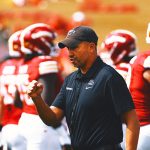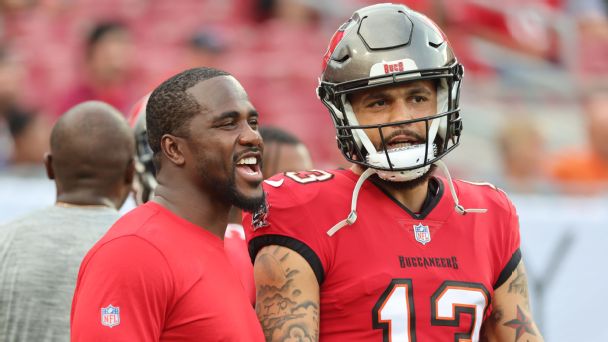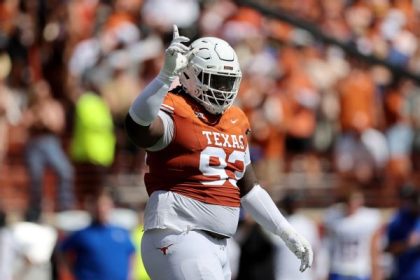
TAMPA, Fla. – Last week, Tampa Bay Buccaneers wide receiver Mike Evans and his agent, Deryk Gilmore, gave the team a Saturday deadline for a new contract — one day before the Bucs open up the season at the Minnesota Vikings (1 p.m. ET, Sunday).
There’s no indication a deal will happen, and Evans and Gilmore said they will not continue discussions with the Buccaneers on an extension after more than a year of negotiations, meaning Evans will play the final year of his deal — stating he doesn’t “want to be a holdout” — and become a free agent in 2024.
“We want the fans to know this is not a tactic and the ball is in the owner’s court,” Evans’ representation, Day 1 Sports and Entertainment, said in a release last week.
So how have general manager Jason Licht and ownership handled recent contract situations?
The Bucs let cornerbacks Carlton Davis and Jamel Dean test free agency before both re-signed in 2022 and 2023, respectively. They didn’t give into inside linebacker Devin White’s request to be traded when he voiced his displeasure over contract negotiations this spring.
They did place the franchise tag on wide receiver Chris Godwin, which served as a place-holder for a new deal to get done a few days later in 2022.
Have there been instances of them agreeing to new deals before current ones expire? Yes. They extended defensive tackle Vita Vea in the midst of a playoff run in 2022 on a four-year deal worth $73 million.
But here, the Bucs might take the same approach that they took with another fan favorite, inside linebacker Lavonte David, in letting Evans test the waters of free agency earlier this year. David did so and went from making $12.5 million per year on his previous contract to a one-year deal worth $4.5 million.
The Bucs have not had great success in recent years with aging free agents like Julio Jones, also a receiver, and Akiem Hicks on short-term deals.
If there’s hesitancy from ownership and the front office to lock up Evans to a long-term deal because he’s now 30, consider what coach Todd Bowles had to say this summer when asked about a potential drop-off in production because of Evans’ age.
“There are a lot of guys that play past 30 years old now,” Bowles said. “That number is thrown out of context a lot, and I think it is about how you take care of your body and how you treat yourself and I think Mike does a great job of that.”
So what would the market for Evans actually look like, and is it even feasible, at 31, if there’s a dropoff this season without retired quarterback Tom Brady?
He is said to be seeking Cooper Kupp money. Kupp, also 30, is currently making $26.7 million per year with $75 million guaranteed. He’s only had two 1,000-yard seasons in six years, but that includes two instances of his seasons being cut in half because of injury. But Kupp also was the 2021 NFL Offensive Player of the Year — leading the league in receiving yards (1,947), receptions (145) and touchdowns (16) — and he also finished 17 yards shy of Calvin Johnson’s single-season receiving record.
Buffalo Bills wide receiver Stefon Diggs, a three-time Pro Bowler who reached 1,000 receiving yards in five out of his eight seasons, has had 29 touchdowns in the last three seasons. He’s also 30 and is making $24 million per year with $70 million guaranteed on a contract signed in April 2022.
Keenan Allen, a five-time Pro Bowler, is 31 and is making $20.025 million per year on a four-year deal worth $80.1 million signed in 2020, has hit 1,000 receiving yards five times in 10 seasons but has never hit more than eight touchdowns in a season.
Evans, on the other hand, has hit the 1,000-yard mark in all nine of his seasons in the league — which has never been done before. Evans’ touchdown production (6) did drop off last season, in comparison to the 14 and 13 he had in the other two years with Brady, but the team’s scoring took a drastic hit as well — going from 30.1 in 2022 and 30.8 in 2021 to 18.4.
“I’ve been blessed to play this game for a really long time,” Evans said. “Been a lot of plays, made a lot of money. … I’m just happy to be in this position I am.”
Evans has also been one of the most durable receivers, missing just seven games because of injury or illness in nine seasons (and two others because of suspensions).
What can’t be quantified as easily are the number of times opposing teams have rolled coverage Evans’ way, affording other pass catchers opportunities. He’s been arguably one of the most consistent presences on a team marred by constant quarterback change before Brady — which includes Josh McCown, Mike Glennon, Jameis Winston and Ryan Fitzpatrick.
The big question that the Bucs are weighing is how long can he play at this level?
The late Vincent Jackson, who mentored Evans and shared a similar playing style, had two consecutive 1,000-yard seasons at the ages of 30 and 31 in 2013 and 2014. But the following two years, he was unable to finish the season because of injuries.
Jones hit 1,000 yards for the final time at age 30 in 2019 when he was with the Atlanta Falcons, and for three consecutive seasons after that, he was unable to play more than 10 games.
But then there’s former Bucs wide receiver Joey Galloway, whose production took a hit in his early 30s before reaching 1,000 yards at the ages of 34, 35 and 36. What if Evans becomes that?
And more recently, Larry Fitzgerald — who last played until age 37 — hit 1,000 yards at ages 32, 33 and 34.
Evans made the point Thursday that other teams are paying two wide receivers $20 million or more per year. He’s referring to the Los Angeles Chargers, with Allen and Mike Williams, but they restructured both of their contracts to clear $14.38 million for 2023. That’s the only instance of a team paying two wide receivers $20 million simultaneously, and they’re doing this while paying Justin Herbert a five-year deal worth $262.5 million, although Herbert’s cap number is just $8.45 million in 2023 and $19.345 million in 2024, before it balloons upward.
As far as the Bucs’ cap situation next season — David and White, left tackle Tristan Wirfs and safety Antoine Winfield Jr. are set to become unrestricted free agents, while Godwin will enter the final year of a three-year deal worth $60 million. And they won’t have a starting quarterback under contract as Baker Mayfield is on a one-year deal with a base of $4 million.
According to Roster Management System, the Bucs will have $36.55 million in salary cap space for 2024 — pending the new cap figure.
The Bucs, who have said on multiple occasions that they want to keep Evans a “Buc for life” are doing some work behind the scenes to improve their financial situation. They restructured Jensen’s contract so that his dead money will now be split at $5.932 million in 2023 and $5.932 million in 2024, and $11.8 million in 2025, so it saves the Bucs $11.3 million in 2024. The Bucs also cleared $10.468 million by restructuring Barrett’s contract this week.
“Obviously we’ve been working with them for over a year now, trying to get something done,” Evans said Thursday. “Any player in my position would want to be secure.”
If a deal doesn’t come to fruition, it doesn’t mean Evans’ time in Tampa is done. The Bucs could franchise tag him, but in 2024, that would cost $28.43 million.
That might not be ideal given the Bucs’ want to save and with Evans simply wanting security, but that’s a path both sides may have to cross in the offseason.











